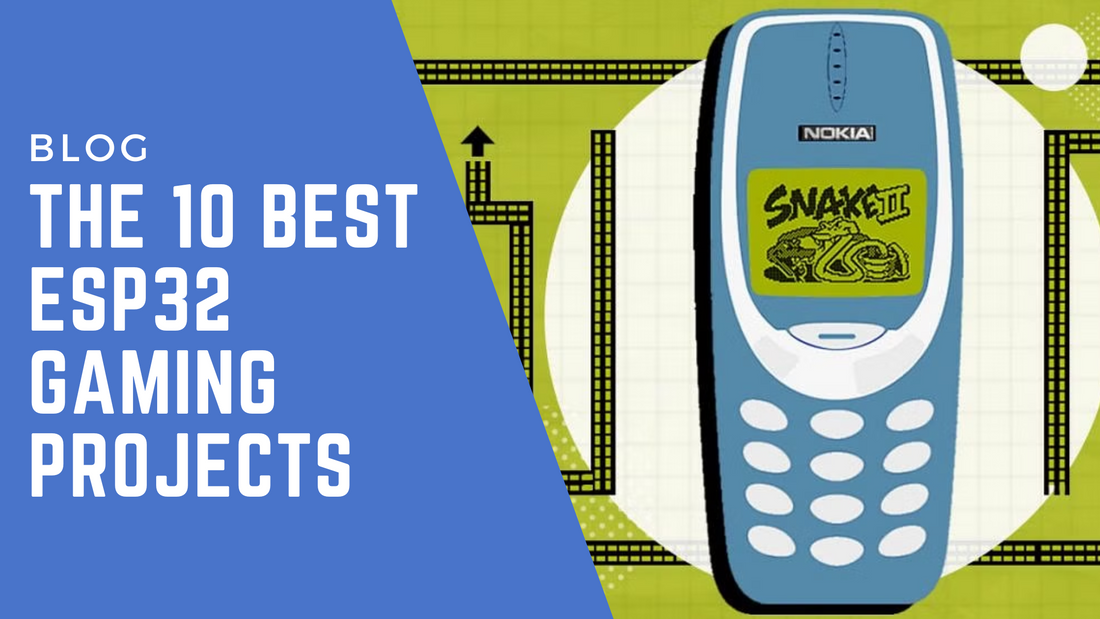
The 10 Best ESP32 Gaming Projects
Games like Rock Paper Scissors, Snake, and Tetris are classics that defined the gaming experiences of the 80s and 90s. Long before the age of online gaming, Android, or Apple platforms, these simple yet addictive games captivated players around the world with their accessible and easy-to-learn gameplay. With the power of the ESP32 based mpythonboard, you can relive these timeless games or even introduce them to a new generation of players.
In this blog, we’ll explore how to design and build classic games on the ESP32 board, including Rock Paper Scissors, Greedy Snake, and Tetris. These games are not only fun to play but also serve as an excellent way to teach coding, game design, and hardware programming using the ESP32.
Classic Game Ideas on ESP32
Let’s take a look at how you can create some classic and simple games using the ESP32 board. These games are easy to program and can be a fun introduction to game development for beginners.
1. Rock Paper Scissors Game on ESP32
Rock Paper Scissors is a simple hand game that has been popular for centuries. With ESP32, you can easily code a digital version that allows the player to compete against the computer.
How It Works:
- The player selects Rock, Paper, or Scissors using buttons or touch sensors connected to the ESP32.
- The ESP32 generates a random choice for the computer.
- The game compares the player’s choice with the computer’s and determines the winner based on traditional Rock Paper Scissors rules.
Game Design Overview:
- Inputs: Three buttons (or touch sensors) for Rock, Paper, and Scissors.
- Output: The result is displayed on a small OLED display or an array of LEDs.
- Random Generation: Use the ESP32’s random number generator to select the computer’s move.
Here’s a basic code example to get you started
[insert image]
2. Greedy Snake (Snake) on ESP32
The Snake game is one of the most recognizable mobile games from the early days of mobile gaming. The gameplay involves controlling a snake to eat food while avoiding running into walls or its own tail.
How It Works:
- The player controls the direction of the snake using buttons or a joystick.
- As the snake eats food, it grows longer, and the game becomes more challenging.
- The game ends when the snake collides with itself or the edges of the screen.
Game Design Overview:
- Inputs: A joystick or directional buttons to control movement.
- Display:OLED to show the snake’s movement.
- Game Logic: Manage the snake’s growth, detect collisions, and generate new food items at random positions.
Here’s an outline of the game logic:
[insert image]
3. Tetris on ESP32
Tetris, another classic from the 80s, is a block-stacking game where the goal is to complete rows by arranging falling shapes. Tetris can be built on ESP32 by using buttons for rotation and movement and a display for the game board.
How It Works:
- The player controls falling shapes by rotating and moving them horizontally.
- When a row is fully filled, it clears, and the player scores points.
- The game ends when the blocks reach the top of the screen.
Game Design Overview:
- Inputs: Buttons to move blocks left, right, and down, and to rotate them.
- Display: On OLED to render the game board.
- Game Logic: Manage block movements, row clearing, and the game’s increasing difficulty over time.
The logic behind implementing Tetris is slightly more advanced, requiring careful management of falling blocks and collision detection with other blocks.
Here are 7 more classic games you can design for the ESP32 mPythonBoard,
4. Breakout (Brick Breaker)
In Breakout, players control a paddle to bounce a ball and break bricks. The goal is to clear all the bricks without letting the ball fall past the paddle. Use the mPythonBoard's display to create the brick layout, and control the paddle using buttons or a tilt sensor.
5. Flappy Bird
Recreate the famous Flappy Bird game where players guide a bird through gaps between pipes. The player taps a button to make the bird "flap" and gain altitude while avoiding obstacles. Use the mpythonboard's OLED display to show the bird and pipes, and a button to control the flapping.
6. Pong
Pong is a one-player game where each player controls a paddle to hit a ball back and forth. The ball speeds up as the game progresses, and players aim to score by getting the ball to stay on paddle. This can be easily implemented with in-built accelerometer for paddle movement and displayed on an OLED screen.
7. Space Invaders
In Space Invaders, players control a spaceship at the bottom of the screen and must shoot down rows of descending aliens. Use the mPythonBoard's OLED display to show the aliens and spaceship, and buttons to shoot/control movement and firing.
8. Catch the Egg
In this game, a basket moves horizontally at the bottom of the screen, and the player needs to catch falling eggs (or objects) by moving the basket left or right. This can be a simple project using buttons for movement and an OLED display for rendering the objects and basket.
9. Memory Game (Simon Says)
Create a memory game where players need to replicate a sequence of flashing lights or tones. Use LEDs or the mPythonBoard's touchpads to display the sequence, and test players' memory by increasing the length of the sequence after each successful round.
10. Maze Runner
In Maze Runner, players navigate through a maze to reach the goal. The maze layout is displayed on the screen, and the player moves a character using buttons or tilt control. Add features like obstacles or enemies for extra challenge.
Conclusion: Designing Classic Games on ESP32
Designing classic games like Rock Paper Scissors, Snake, and Tetris on the ESP32 board is not only a fun challenge but also an excellent way to learn about game design, programming, and hardware interaction. These simple games can be made with just a few buttons, a display, and an ESP32 microcontroller, making them accessible.
